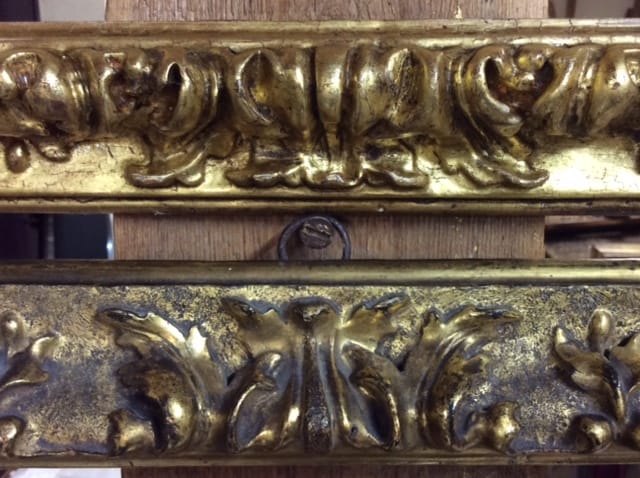Discover ANTIQUE GOLD FRAME REPAIR secrets to restore original splendor and protect the historic charm of your treasured frames.
If you’ve ever admired an ornate gilded frame from generations past, you already know how these masterpieces can elevate artwork and décor. But what happens when age, wear, or accidents mar their beauty? ANTIQUE GOLD FRAME REPAIR is the key to restoring their former glory. Drawing on traditional methods and modern expertise, this article walks you through the basics of identifying damage, gathering essential materials, and taking the correct steps to rehabilitate precious frames. Read on to learn how to bring your antique gold frames back to life and keep them looking stunning for decades to come.
For a successful antique gold frame repair, follow these key steps:
- Understanding the Value of Antique Gold Frames
- Common Signs of Damage
- Essential Tools and Materials
- Prepping for Antique Gold Frame Repair
- Restoring Surface Imperfections
- Re-Gilding Techniques
- Reassembling and Securing the Frame
- Long-Term Protection and Maintenance
- When to Consult a Professional Restorer
These sections guide you from assessing your frame’s condition to ensuring its long-term preservation.
Continue reading to discover how each step, from diagnosing damage to applying gold leaf, contributes to a restoration that honors the craftsmanship and history of your antique frame.
1. Understanding the Value of Antique Gold Frames
Antique gold frames are more than just decorative borders—they’re tangible pieces of art history. Whether they adorn a prized painting or hold a family portrait, these frames often reflect the style and techniques of a particular era. Intricate carvings and genuine gold leaf detailing point to the skill of artisans who dedicated countless hours to creating timeless beauty. In today’s market, well-preserved antique frames can hold significant monetary and sentimental value, thanks to their rarity and craftsmanship.
From a collector’s standpoint, an authentic gold frame can enhance the artwork it surrounds while also standing on its own as a statement piece. The luminous glow of gold leaf and the complexity of its ornamentation can instantly elevate any room, blending heritage with elegance. By understanding a frame’s value—both aesthetically and historically—you’ll be better equipped to approach its repair with respect and the right techniques. Once restored, it can continue to serve as a link between past and present, enchanting viewers with its storied charm.
2. Common Signs of Damage
Even with careful handling, antique gold frames can suffer a variety of ailments over time. One common issue is flaking or chipping of the gilded surface, which exposes the underlying gesso or wood. Moisture, temperature shifts, and simple aging can also cause cracks or separation in the frame’s joints. In more severe cases, you might notice missing decorative elements or deep gouges in the wood.
Another telltale sign of damage is the presence of tarnish or discoloration on the gold finish. Although real gold leaf resists corrosion better than faux alternatives, it can still lose its luster when exposed to certain environmental factors or improper cleaning methods. Loose corner joints, rattling components, or warping are all signals that structural issues may need attention. Recognizing these indicators early is essential. Prompt repairs not only safeguard the frame’s appearance but also prevent further deterioration, helping you avoid more extensive—and expensive—restorations down the line.
3. Essential Tools and Materials
Successful antique gold frame repair often hinges on having the right tools and supplies. Begin with a soft brush and microfiber cloth for gentle dust removal. You’ll also need items like wood glue and clamps to secure loose joints or reattach broken pieces. If the frame has missing ornaments, consider using clay or resin-based molding compounds to replicate the original design, paying special attention to intricate details.
For refinishing and gilding, a high-quality gesso is vital, as it lays the groundwork for the gold leaf. Genuine gold leaf can be purchased in sheets, though a variety of metal leaf substitutes exist if budget is a concern. Additionally, you’ll want an adhesive called “size” to help the leaf stick, plus specialized brushes for application and burnishing tools to achieve that signature shine. Completing the toolkit, stock up on protective materials like gloves and drop cloths to keep the frame and surrounding area clean. By gathering all these essentials beforehand, you’ll save time and ensure a smoother, more professional repair process.
4. Prepping for Antique Gold Frame Repair
Preparation is everything when it comes to bringing a gilded frame back to life. Start by placing the frame on a stable, flat surface in a well-lit area. This allows you to inspect its entire surface, inside and out, for any potential weaknesses or hidden damage. Before making any repairs, be sure the frame is free of dust and debris—use a soft brush or gentle vacuum setting to remove buildup from crevices.
Next, evaluate which parts of the frame need attention. Sometimes a quick regluing of a corner is enough, while other cases demand in-depth restoration of both structural and decorative elements. At this stage, take photographs or sketches, especially if there are missing motifs that need to be recreated. This visual reference becomes invaluable when sculpting or attaching newly molded sections. Finally, gather all required tools and keep them within easy reach. Having your materials prepared and your frame stabilized sets the stage for a careful, precise, and ultimately successful antique gold frame repair.
5. Restoring Surface Imperfections
Addressing surface-level flaws is a crucial step in reviving an antique gold frame. Flaking gilding, hairline cracks, or even small chips can all be remedied with patience and the correct materials. Begin by carefully scraping away any loose or unstable pieces of gesso or gold leaf. This ensures that further layers you apply won’t peel or detach over time.
If sections of the decorative design are lost, you can recreate them using a molding compound, referencing intact areas of the frame for consistency. Once the molding is set, gently sand or carve the new section to blend with the original. Next, apply gesso to the repaired areas, allowing it to dry fully before lightly sanding. This step smooths out transitions and prepares the surface for re-gilding. By methodically tackling each imperfection, you preserve the frame’s authenticity while laying the groundwork for a uniform, refined finish that will soon dazzle again.
6. Re-Gilding Techniques
Re-gilding is where an antique gold frame truly regains its former splendor. First, you’ll apply a gilding adhesive—often called “size”—to the area you’re restoring. It’s essential to let this adhesive reach the proper tackiness level, which usually feels slightly sticky but not wet. Carefully lay the gold leaf over the adhesive, pressing it gently to conform to the frame’s contours. Soft brushes can help smooth out wrinkles and burnish the leaf for a seamless look.
For more intricate frames, consider using smaller pieces of leaf so that you can navigate tight corners or raised details without overlapping large sections. Patience is key here; rushing can lead to tearing or uneven application. Once the leaf is in place, let it cure according to the adhesive’s guidelines. After curing, use a clean brush or specialized burnishing tool to buff the gold leaf, enhancing its shine. If desired, you can apply a thin protective sealant or toning agent to achieve the exact hue or patina that matches the rest of the frame. Done correctly, re-gilding breathes new life into antique frames, rekindling the glow that may have faded over time.
7. Reassembling and Securing the Frame
After you’ve addressed the frame’s aesthetic issues, it’s time to reassemble any separated parts and reinforce the structure. Antique frames often have corner joints secured by nails, dowels, or specialized fasteners that can loosen over years of display. Carefully align these joints, adding a thin layer of wood glue if needed, before clamping them in place. Allow ample drying time—rushing this step may compromise the frame’s stability.
If the frame includes decorative trims or moldings that have detached, use a gentle adhesive recommended for wood and gesso-based materials. Press them firmly into position, wiping away excess glue to maintain a clean look. Check that all areas align properly, making minor adjustments as required. Once fully set, any gaps or seams can be filled with a little gesso and touched up with gold leaf or paint. This thorough approach ensures your antique gold frame not only looks beautiful but also holds together reliably, ready for safe display in any setting.
8. Long-Term Protection and Maintenance
Even the best restoration won’t last without proper care and maintenance. Display your antique gold frame in an environment with stable temperature and humidity levels—dramatic fluctuations can cause wood to expand or contract, jeopardizing the newly repaired joints or gilding. Regularly dust the frame with a soft cloth or feather duster, avoiding harsh chemicals or abrasive materials that could dull the finish.
When cleaning is necessary, a mild solution of water and pH-neutral soap can remove light grime without damaging the gold leaf. Always test this mixture on a small, inconspicuous area first. Stay vigilant for early signs of new damage, such as hairline cracks, peeling leaf, or loosening components. Prompt attention to minor issues helps stave off more intensive repairs later. Investing time in consistent, gentle upkeep ensures that your frame retains its renewed sparkle and remains a testament to the rich heritage it represents.
9. When to Consult a Professional Restorer
While many homeowners can handle basic frame repairs, certain challenges call for professional expertise. For instance, frames with extensive missing carvings or severe structural damage may require specialized tools and advanced restoration skills. If you notice signs of wood rot, large-scale warping, or a drastically compromised gilding surface, it’s worth seeking out an experienced conservator.
Professionals not only possess the artistic skills to replicate ornate details but also have access to conservation-grade materials that can ensure lasting results. They can accurately color-match gold leaf to the frame’s existing patina, preserving its historical appearance. Moreover, professional restorers often keep detailed documentation of every stage in the repair process—a practice especially important for museum-grade pieces or family heirlooms. Enlisting expert help for complicated restorations allows you to avoid costly mistakes while ensuring your antique gold frame remains a stunning heirloom for years to come.
FAQ
Can I use regular gold paint instead of gold leaf for repairs?
Gold paint can be a quick fix, but it lacks the depth, luminosity, and authenticity of real gold leaf. For best results, use proper gilding techniques.
How do I fix small scratches or nicks in the gold surface?
You can gently fill minor scratches with gesso and reapply gold leaf in that area. Ensure the surrounding leaf is intact so the patch blends seamlessly.
What if the frame’s wood is cracked or warped?
Address any significant structural damage with wood glue, clamps, and possibly dowels. If the issue is severe, consider consulting a professional restorer.
Do I need special tools for burnishing gold leaf?
Yes, specialized burnishing tools or soft brushes help smooth the leaf without tearing. A light touch is crucial to avoid damaging the delicate surface.
How often should I clean or dust an antique gold frame?
A gentle dusting every few weeks is sufficient. Deeper cleaning can be done occasionally with mild soap and water, but always test on a small area first.
Conclusion
Tackling ANTIQUE GOLD FRAME REPAIR is both an art and a craft, requiring a balanced mix of patience, skill, and reverence for history. By inspecting carefully, choosing top-quality materials, and applying time-honored gilding and restoration techniques, you can return your frame to its original splendor. Regular maintenance and the occasional touch-up will keep it shining for years, while professional expertise remains an option for the most complex challenges. In the end, restoring an antique gold frame is more than a mere fix—it’s a way to preserve a piece of the past and ensure it continues to enchant admirers well into the future.





